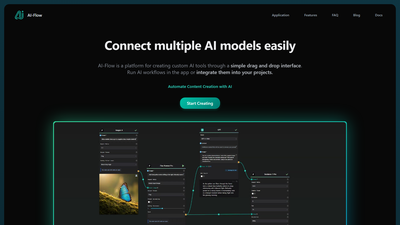AI-Flow
Connect multiple AI models easily.
AI Integration Open-source Open-source Platform AI Modeling User-friendly Interface Drag-and-Drop FunctionalityTool Information
| Primary Task | Workflow automation |
|---|---|
| Category | technology-and-development |
| Sub Categories | api-and-development-tools no-code-platforms machine-learning-models |
| Open Source | Yes |
AI-Flow is an open-source platform that connects multiple AI models through an easy-to-use graphical interface. It makes AI accessible to innovators and creators by allowing users to combine different AI models for unique results. With models like GPT-4o, DALL-E 3, Replicate, Claude 3, and Stable Diffusion 3, users can create custom AI tools quickly using a drag-and-drop interface. This enables tasks like creating illustrated stories or summarizing web content in minutes. AI-Flow is also flexible, offering customizable AI solutions to meet specific needs. This makes it suitable for a wide range of users, from individual creators to large corporations.
Ik help bedrijven met het begrijpen en inzetten van AI 🚀
| Pros |
|---|
|
| Cons |
|---|
|
Frequently Asked Questions
1. What is AI-Flow?
AI-Flow is an open-source platform that facilitates the connection of multiple artificial intelligence models via an easy-to-use graphical interface. It is designed to make AI more accessible to innovators and creators. Key features of AI-Flow include the ability to combine different AI models for unique results, user-friendly drag-and-drop interface, and capability to create bespoke AI tools swiftly. This platform demonstrates flexibility by customizing AI solutions to meet specific user needs, making it adaptable across diverse scenarios.
2. What models can be connected using AI-Flow?
AI-Flow can connect a range of AI models, some of them include GPT-4, DALL-E 3, Stable Diffusion, Replicate, LLaMa 2, GPT-3.5, Mistral, ControlNet, Stable Video Diffusion, MusicGen, Blip-2, Face Swap and GPT Vision.
3. What are the main features of AI-Flow?
The main features of AI-Flow are its easy-to-use graphical interface, drag-and-drop functionality, the ability to connect multiple AI models for unique results, the ease of creating custom AI tools within minutes, and its adaptability in tailor-making the AI solutions to meet specific user needs. It is designed to democratize AI and make it more accessible for creative innovators.
4. How accessible is AI-Flow to non-technical users?
AI-Flow is highly accessible to non-technical users, primarily due to its intuitive graphical interface that emphasizes drag-and-drop functionality. This feature versatility enables even those with limited technical expertise to create custom AI tools within minutes and combine AI models for unique results.
5. What is the significance of AI-Flow's drag-and-drop functionality?
The drag-and-drop functionality in AI-Flow simplifies the usually complex process of combining different AI models. It allows users to intuitively create AI tools by just dragging and dropping their preferred models. This functionality significantly reduces time and technical hurdles in creating AI solutions, making it a key aspect of the platform's user-friendliness.
6. Can I customize AI models with AI-Flow?
Yes, AI-Flow provides capabilities for customizing AI solutions to meet specific user requirements. This allows it to be tailored across diverse scenarios as per the requirements of the project.
7. How does AI-Flow make AI accessible to creatives?
AI-Flow makes AI accessible to creatives by providing an open-source platform where they can easily combine various AI models to make unique creations. Its drag-and-drop functionality allows creative innovators to build bespoke AI tools within minutes, and its flexibility in customizations enables it to adapt to various creative scenarios.
8. What unique results can be achieved by combining AI models in AI-Flow?
The combination of AI models in AI-Flow can yield unique results catered to a wide array of objectives. For instance, users can create illustrated stories, generate summaries and analyses of web content, convert text into video, and develop other bespoke AI tools depending on the AI models used and their specific fusion.
9. How quickly can I create tools with AI-Flow?
With AI-Flow, users can swiftly create their own AI tools in just a few minutes thanks to its intuitive drag-and-drop interface.
10. Does AI-Flow cater to both individual creators and corporations?
Yes, AI-Flow caters to a broad user base, ranging from individual creators to larger corporations. Its ability to customize AI solutions as per specific needs makes it adaptable for different use cases, regardless of the scale.
11. Can AI-Flow help me create illustrated stories?
Yes, AI-Flow provides the functionality to aid in the creation of illustrated stories. This is enabled through its ability to combine several AI models for unique results.
12. Can AI-Flow be used to analyze web content?
Yes, AI-Flow has capabilities to analyze web content. By leveraging certain AI models, the tool can be used to summarize and analyze content in an automated manner.
13. What makes AI-Flow's user interface stand out?
AI-Flow's user interface stands out due to its simplicity and user-friendliness. Despite the complexity of the AI models that it can connect, it maintains a drag-and-drop functionality that even those with limited technical skills can easily navigate to create custom AI tools in minutes.
14. What AI models does AI-Flow support?
AI-Flow supports a range of artificial intelligence models. They include GPT-4, DALL-E 3, Stable Diffusion, Replicate, LLaMa 2, GPT-3.5, Mistral, ControlNet, Stable Video Diffusion, MusicGen, Blip-2, Face Swap and GPT Vision.
15. What does it mean that AI-Flow is open-source?
Being open-source signifies that AI-Flow's source code is publicly available, allowing anyone to view, use, modify, and distribute the project for any purpose. This contributes to community collaboration and continual improvement of the platform.
16. How does AI-Flow contribute to AI democratization?
AI-Flow contributes to the democratization of AI by making it more accessible to a wider audience. This is achieved by providing an intuitive, user-friendly platform where even those with limited technical expertise can create and customize AI tools and solutions.
17. Is there a trial version of AI-Flow?
Yes, a trial version of AI-Flow is available as mentioned on their website.
18. How can I follow updates about AI-Flow?
Updates about AI-Flow can be followed on Twitter and Github. The respective links are provided on the website.
19. Where can I find the documentation for AI-Flow?
The documentation for AI-Flow can be found on a dedicated Docs page. The link to access this page is available on their website.
 AI Tool Buzz
AI Tool Buzz

 n8n.io
n8n.io Waveloom
Waveloom